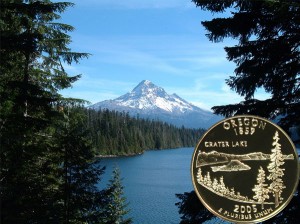Today, the Oregon State Quarter Coin tells the story of names 222 years ago.
As part of George Vancouver’s voyage with the Discovery in 1792, Lt. William Broughton captained the accompanying vessel, the Chatham.
On October 21, he and his crew anchored near the mouth of the Columbia River during a heavy gale.
After several days on the river, Lt. Broughton and several men left the larger Chatham and continued upstream in smaller boats.
In Chapter III of Book III of A Voyage of Discovery to the North Pacific Ocean, And Round the World printed in 1801, George Vancouver described the exploration by Lt. Broughton up the Columbia.
One day in particular:
=====
The next morning, (October 29) they again proceeded up the river, and had a distant view of mount St. Helens, lying N. 42 E.
In sounding across the river, whose width was here about a quarter of a mile, from three to twelve fathoms water was found.
Owing to the rapidity of the stream against them they were under the necessity of stopping to dine at not more than four or five miles from their resting place; here it was low water at noon, and though the water of the river evidently rose afterwards, yet the stream continued to run rapidly down.
The greatest perpendicular rise and fall appeared to be about three feet. In this situation the latitude was observed to be 45° 41. , longitude 237° 20′; when mount St. Helens was seen lying from hence being about eight miles.
In their way hither they had passed two Indian villages on the west side of the river, and had been joined by an hundred and fifty of the natives in twenty-five canoes.
To avoid any surprise they dined in their boats; this precaution was however unnecessary, for on some trivial presents being made, a trade immediately commenced, in which the Indians conducted themselves with the utmost decorum.
No attempts were made to pass the line drawn on the beach, excepting by two who appeared to be the principal chiefs, and who were permitted to join the party.
These seemed to be very well disposed, and inclined to communicate every information; but, unfortunately for our gentlemen, a total ignorance of the Indians’ language precluded their profiting by these friendly intentions.
At one o’clock they quitted their dinner station, and after rowing about five miles, still in the direction of the river S. 5 E. they passed on the western side a small river leading to the south -westward; and half a mile further on the same shore came to a larger one, that took a more southerly course.
In the entrance of the latter, about a quarter of a mile in width, are two small woody islets ; the soundings across it from two to five fathoms.
The adjacent country, extending from its banks, presented a most beautiful appearance.
This river Mr. Broughton distinguished by the name of River Munnings. — Its southern point of entrance, situated in latitude 45° 39′, longitude 237° 21 ‘, commanded a most delightful prospect of the surrounding region, and obtained the name of Belle Vue Point; from whence the branch of the river, at least that which was so considered, took a direction about S. 57 E. for a league and a half.
A very distant high snowy mountain now appeared rising beautifully conspicuous in the midst of an extensive tract of low, or moderately elevated, land, lying S. 67 E. and seemed to announce a termination to the river.
From Belle Vue Point they proceeded in the above direction, passing a small wooded island, about three miles in extent, situated in the middle of the stream.
Their route was between this island and the southern more, which is low ; the soundings between its north west point and the main land were three fathoms, increasing to four, five, and six, off its south east point ; from whence the river took its course S. 75 E.
This obtained the name of Menzies Island ; near the east end of which is a small sandy woody island that was covered with wild geese.
From Belle Vue Point, a small stream of flood had attended them to this station; but here a rapid downward current was met, though Indian companions, excepting one elderly chief, who, in the most civil and friendly manner had accompanied them from the first, and had a village still farther up the river.
Having received many presents he had become much attached to the party, and, to manifest his gratitude, he now went forward to provide them with lodgings, and whatever acceptable refreshments his village might afford.
About seven in the evening they reached his habitation, where he much wished them to remain ; but preferring a more secluded resting place, they resorted to a shallow creek a mile further up the river, and about eight miles from Belle Vue Point, where they passed the night.
=====
Vancouver further described Lt. Broughton’s view of the snowy mountain and his naming convention:
“Its lofty summit was scarcely more distinct across the intervening land which was more than moderately elevated. Mr. Broughton honoured it with Lord Hood’s name; its appearance was magnificent; and it was clothed in snow from its summit, as low down as the high land, by which it was intercepted, permitted it to be visible. ”
The Oregon State Quarter Coin shows against a background of the snowy Mt. Hood that was named 222 years ago today.
